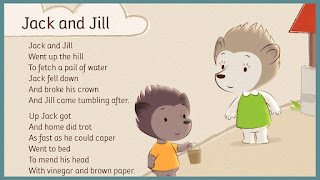J is for Jack and Jill
English classrooms in India can be depressing places to observe. The content has been taken from a distant Western practice, British or American, with all its nuances within its own context. The teaching is delivered by someone unaware of the context, someone who means well but is doomed to fail in the teaching because they cannot put life into the subject matter. That is the case with Nursery Rhymes, such as
Jack and Jill
Went up the hill
To fetch a pail of water
Jack fell down
And broke his crown
And Jill came tumbling after!
In the case of this and almost all other Nursery Rhymes, what the children hear is a meaningless jingle, as Rabindranath Tagore reported about his own early days in school. For the teacher the pitfalls are many, starting with four troubling words: fetch, pail, crown, tumbling. The first three are not in common colloquial use today in everyday English speech. The last can be difficult to properly explain.
There are a number of other problems that also attend teaching and learning in early childhood education in India. The teacher is not phonetically adept and does not pick on the small vowel sounds in most rhymes; here: went, fell, fetch (small e); Jack, and (small a); Jill, hill (small i); up, tumbling (small u). Indeed, the teachers I observed did not know how to say ‘pail,’ never having encountered the word before. Second, most teachers are not trained in how to make early childhood learning pleasurable and fun: they do not joke, laugh, playact, or require all this from their children. A little playacting with each Nursery Rhyme would go a long way. And I do not mean the realistic mimetic movements that are woodenly taught at times.
My pain at watching the struggles of both teacher and student with a “Jack and Jill” type of rhyme is accompanied by an anger at the top-down state action of the mid nineteenth century when English was mandated to be the language of higher learning in India, a mandate that filtered down gradually to make English teaching start earlier and earlier. It’s perfectly fine to learn English. One could argue that modern India would have been poorer without it. If one does, however, one must concede that there must be a set of techniques for it, a pedagogic strategy.
The New Education Policy that has been declared effective as we speak, that is, on 7th March 2023, declares that up to Grade 6, or the age of 12, teaching should not be in English but in the provincial Indian language. A wonderful thought! But once again a top-down state decision not accompanied by the will of the people or supported by market forces. How, in Grade 6, will children jump
from say, Hindi or Gujarati, to English as the medium of study without a proper plan of action? It will be the same solution as at present: the family will be called upon to perform part of the task of the school, and the family, being mostly unequipped to do so, will call upon middlemen. Children will experience one course of study in school and be subjected to a parallel course at home or with tutors. Neither the family nor the tutors being experts, most children will fail to become good learners and skilled in their subjects.
Instead, the state, if indeed it wants to take charge of education, should develop the publishing industry, and support the literary and arts sectors, to make thousands of materials available for children in the early years. At present, the capacities of children in Pre and Primary school continue to be grossly under-stimulated because rhymes, stories, music, dance and theatre for children in those years is under-developed. Some of us survived so far in the shadow of the West and managed to enjoy schooling because of all the resources we could borrow from the West, starting with rhymes and stories. Now, with English banned, there will be a sudden vacuum.
My own solution is to push for bilingualism, since it is a well-known fact that children can learn more than one language very easily in their early years. There is no other way, if we want to recognize both the value of English for functioning in global marketplaces, and of the mother tongue for being happy in our skins, and of both for understanding other subjects and the world around us with curiosity and pleasure. For this even more pedagogic strategies have to be developed.
Jams and jellies can allow adults to introduce some fruits into snacks, given that we have to satisfy sugar cravings one way or the other. So, bread, roti or paratha with a jam or jelly can fulfill the carbohydrate-vitamin-fat-protein goal of a child’s meal if supplemented by some nuts or sprouted dals. However, as with juices, there is a dearth of hearty and inexpensive jams or jellies in the market. Why could our lovely guavas, mangoes, and oranges not be used instead of an artificially pink pseudo ‘strawberry’ concoction that monopolises the jam market? When I last looked, it was easy enough to cook up the fruits into jams.
I suppose we are too busy with our traffic jams.




Comments
Post a Comment